
If you’ve been paying attention to the white supremacist mobs and lunatic anti-vaxxers assaulting school board meetings, the increasing death threats against Democrat politicians, the growing talk of civil war, and a Republican Party that encourages all this, you can feel the dark cloud of fascist violence hanging over this country. All of this at a time when fascist vigilantes are on trial in Kenosha, Charlottesville, and south Georgia—where Ahmaud Arbery’s killers are literally using an 1863 slave catcher law, a law used for 100 years to justify lynchings, as their defense! Whether the court cases happening now end up green-lighting white supremacist vigilantism or not, it's not hard to imagine this frenzy of fascist threats of growing violence growing through the near future. In fact, a recent New York Times article compared the current “menace” of Republican violence to the 1830-1860 period of political violence when there were more than 70 brawls, duals, and other violent incidents in and around Congress.
I recently started watching the three-part PBS documentary The Abolitionists. The Civil War represented a clash between two different modes of production—a slave system in the South and a “free labor” capitalist system in the North—which were increasingly coming into conflict in various ways. This was the stage on which a fierce political and moral struggle was waged, which eventually erupted into all-out war in which the North triumphed and slavery was abolished. The trajectory and outcome of this was not preordained. It had to be fought for.
The Abolitionists brings to life the stories of five passionate anti-slavery activists—Frederick Douglass, William Lloyd Garrison, Angelina Grimké, Harriet Beecher Stowe, and John Brown. I’ve only watched the first part of this series, but the main thing that stands out so far is the very dynamic role that a handful of committed abolitionists played in heightening and sharpening the contradictions in the country, pushing things to extremes, polarizing society and then working to re-polarize it toward the goal of ending slavery. The mere existence of abolitionist agitation and propaganda, fueled the ire of the pro-slavery forces who became increasingly hardened, unleashing brutal mob violence against them, including in Northern cities like Boston, Philly, and New York City. At the same time, we see the abolitionists also becoming more hardened, breaking from the naive view that they could just appeal to the Christian conscience of the slaveholders. The dynamic effect of their actions went way beyond what they could plan or predict—for example, William Lloyd Garrison and his anti-slavery newspaper The Liberator were not well known, but then he got blamed by the Southern slavers for inciting Nat Turner's rebellion1, launching him into notoriety. Garrison did not shy away from this, but seized on it to step up his agitation.
There were a number of other interesting and important points in the first episode that stood out to me. One was the interconnection between the fight against slavery and the beginning movement for women’s equality. Another was the powerful role and arousing effect of putting the visceral reality of slavery before people—for example, Grimké wrote a whole book which became the number one bestseller in the country, detailing the horror of slavery through personal testimony from those affected by it and the words of the slaveholders themselves.
The main point is, go watch this series! It really made me think about what a disproportionate effect a small number of people can have, filled with passionate intensity and driven by an uncompromising vision at a critical moment in history.
For more info on The Abolitionists and how to watch go here.